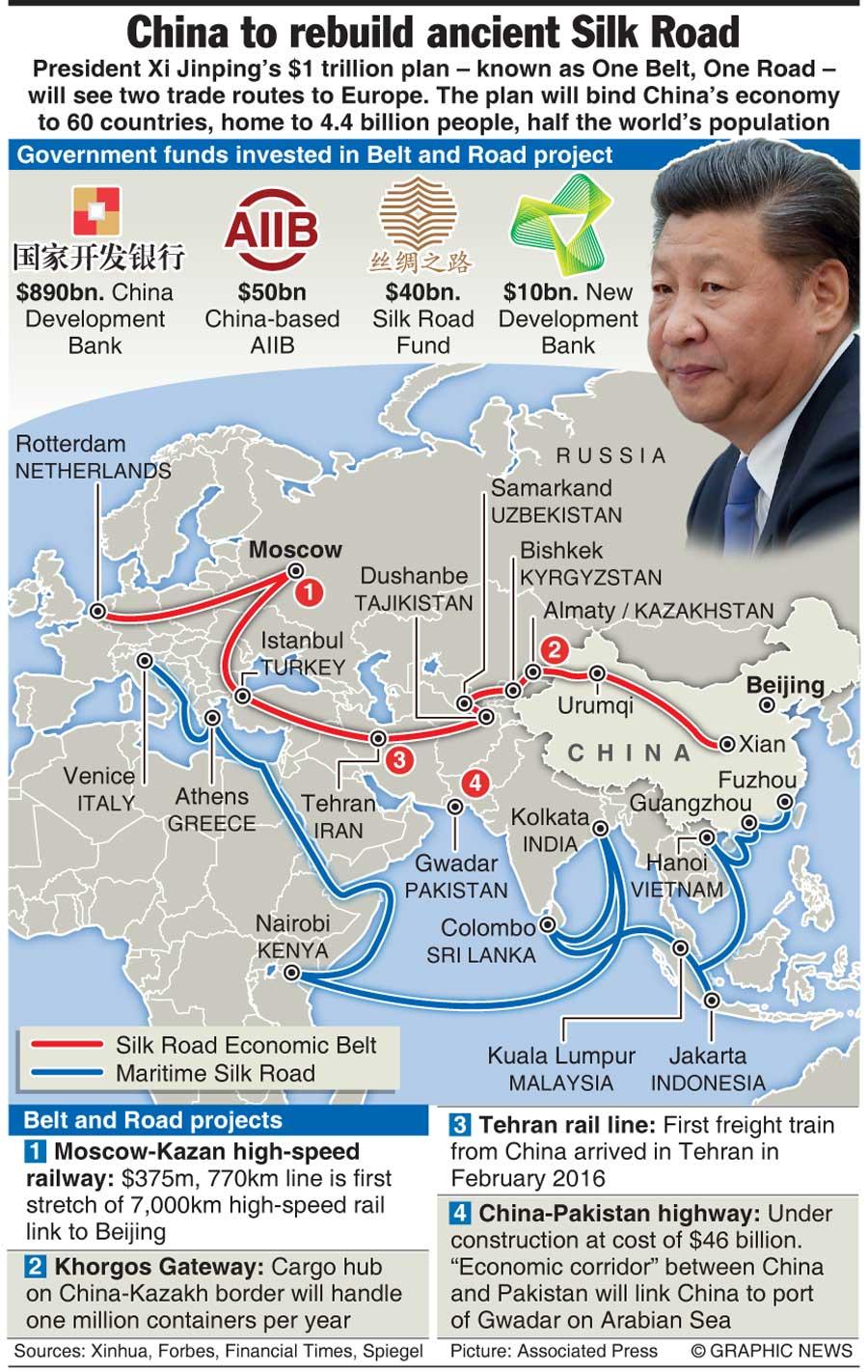Reply To:
Name - Reply Comment
 Last week, journalists from several countries gathered in Islamabad to exchange ideas on a Belt-and-Road media network. Such a network, as envisioned by Chinese President Xi Jinping, had a soft launch in Beijing in April this year. Called the Belt and Road News Network (BRNN), it seeks to boost “understanding, friendship and cooperation, and form a normalised mechanism for collaboration” across countries which are members of the trillion dollar BRI network.
Last week, journalists from several countries gathered in Islamabad to exchange ideas on a Belt-and-Road media network. Such a network, as envisioned by Chinese President Xi Jinping, had a soft launch in Beijing in April this year. Called the Belt and Road News Network (BRNN), it seeks to boost “understanding, friendship and cooperation, and form a normalised mechanism for collaboration” across countries which are members of the trillion dollar BRI network.
In promoting this networking programme, the Islamabad-based Center for Global & Strategic Studies (CGSS) last week organised an international conference on “Cross-Regional Media Fusion among the Belt and Road Partners”. Journalists from Azerbaijan, Belarus, China, Iran, Kyrgyz Republic, Sri Lanka, Tajikistan and Uzbekistan took part in the conference.
Prime Minister Imran Khan’s special advisor on media affairs, Dr. Firdous Ashiq Awan, was the chief guest. She said Chinese President Xi Jinping’s BRI vision was a harbinger of a new era of connectivity and would bridge the gap between the North and the South. “The BRI and the China-Pakistan Economic Corridor (CPEC) are reshaping the geo-economic landscape and bringing not only prosperity for Pakistan but shared development for the entire region,” she said
Dr. Firdous said she appreciated the positive role of the Pakistani media in eliminating the negative propaganda against the CPEC.
Pang Chunxue, Deputy Chief of Mission at the Chinese Embassy in Islamabad, told the conference China, as the engine of world economic growth, had brought more opportunities for shared development for all BRI partners. “China is building a new model that features no conflict, rejects cold war, power politics and creates win-win situations for all. China has promoted peaceful diplomacy and cooperation that aims at building a world with shared prosperity. In a nutshell, peace and stability is the need of the time and the BRI is important to achieve this goal,” she said.
Visions and goals are one thing, but the ground reality is totally another. Asymmetry is the salient feature of the BRI, be it development or media freedom.
On matters development, the BRI can bring in the anticipated fusion with investment flowing in from the Centre – China – to the periphery or other BRI partner states. Any Centre-Periphery relationship kindles memories of the colonial era that existed from the 16th century to the mid 20th century. Therefore, the burden is on China to allay suspicion that the BRI is not aimed at recreating a neocolonialist world order. What is encouraging to see is that China has been categorical in denying that it has any neocolonial agenda.
The Chinese delegation at the conference was emphatic in its assertion that China did not harbor expansionist ideas through the BRI. It is on such assurances that the BRI media network is trying to make linkages among partner country journalists. Just as with development and economic progress, there is asymmetry in media structures of partner countries. Certainly, Sri Lanka’s media development is not similar to that of China. On the Paris-based Reporters Sans Frontiers’ Press Freedom Index for 2019, Sri Lanka is placed 126th while China is placed 177th. Pakistan is 142, Belarus 153, Kazakhstan 158 and Uzbekistan is 160.
With vast disparities in media freedom, the BRI media network is not going to be like the media linkages Sri Lanka had with the British Commonwealth which through the now defunct Commonwealth Press Union tried to promote media freedom, democracy and human rights.
Then there were moves to set up South Asian media linkages within the framework of the South Asian Association of Regional Cooperation. Due to SAARC’s structural weaknesses, media connectivity proposals are gathering dusts in the SAARC archive. The BRI media network President Xi seeks to activate is also far from the New Information Order which developing countries sought to bring about during the heydays of the Non-Aligned Movement.
Unlike most BRI nations, Sri Lanka has a long tradition of independent media culture. The arrival of the printing press in the country in 1737 during the Dutch colonial period laid the foundation for an early print media culture in Sri Lanka.
The Sri Lanka print media’s early development had its origins in the work of European missionaries and measures taken by the Sinhala Buddhists and the Hindu Tamils to resist it. This daunting task and the challenges faced by the Sinhalese, the Tamils and the Muslims defined the shape and tone of the media throughout its subsequent history in the runup to Independence in 1948.
"In a nutshell, peace and stability is the need of the time and the BRI is important to achieve this goal"
Our independence struggle was largely non-violent, with the media playing a significant role in awakening the people and rallying them for freedom.
But after Independence in 1948, press freedom suffered. Soon, there emerged three streams of media: The objective media, the state-owned media and the privately owned partisan media. This is virtually the good, the bad and the ugly of Sri Lanka’s journalism even today.
Due to our colonial past, Sri Lanka’s media culture has an inbuilt aversion to imperialism. Sri Lanka also has an active socialist political movement that has resisted Western nation’s neo-colonialist efforts to bring Sri Lanka under their control.
Given this backdrop, the independent segment of the Sri Lanka’s media is suspicious of big powers’ agenda in Sri Lanka, although our history shows that Sri Lanka has benefited from trade with foreign nations, including China.
Such suspicion exists, notwithstanding China’s help to Sri Lanka through the Rubber-Rice agreement in 1952, the Bandaranaike Memorial International Conference Hall which stands as a monument for friendship and values the two countries share in promoting global justice, and the ongoing BRI flagship projects such as the Hambantota Port and the Colombo Financial City development. Besides, the BRI is not incompatible with Sri Lanka’s economic vision of making its key ports the regional and international hub of trade
and investment.
As China’s interactions and trade relations with Sri Lanka send mixed signals, media focus on the BRI is imperative to ensure that Sri Lanka’s interests are not undermined. It is in this context, a wider BRI media network is necessary and China, too, recognizes it. Through media linkages, the BRI partner countries can share their experiences in addressing suspicion and concerns over BRI network’s weaker countries falling into what the Western nations describe as China’s debt trap.
There are positives, too, apart from the BRI’s negativities, especially the viewpoint that it was the modern day East India Company that paved the way for Britain to colonise the Indian subcontinent.
Nations avoid wars and give priority to peaceful means of conflict resolution, when they are bound by mutually beneficial trade. The United Nations has acknowledged that trade plays a major role in alleviating global poverty. Then there is China’s foreign policy stand which is also compatible with those of developing nations.
Therefore, media in BRI partner countries can play an important role in promoting not only mutually beneficial and compatible economic visions, but also shared values aimed at world peace.
Trade and cultural exchanges enhance friendship between nations and people-to-people contacts. The BRI media network can emerge as a global movement for peace and development journalism.
